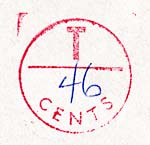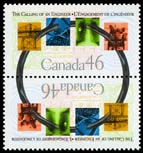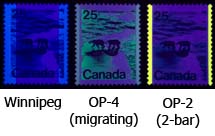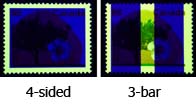
|
Elizabethan II Study Group Journal: The Corgi Times Glossary |
T | |||||||||||||||||||||||||||||
| T - (French Taxe) hand-struck on cover, indicates postage due, and is stamped upon insufficiently paid mail. Is recognized internationally as an alternative to stamps specially printed for the purpose. |
 T (tax due) |
||||||||||||||||||||||||||||
| Tab - coupon, or other label attachment to a stamp. | |||||||||||||||||||||||||||||
| Tagging -
phosphor coating on stamps used to activate automatic mail-handling equipment. This may be lines, bars, part of the design area or the entire stamp surface. Some stamps are issued both with and without tagging. Catalogues call them tagged and untagged.
In some cases, the tagging is omitted in
error. An ultraviolet light is usually required to identify tagged stamps, but with experience you may be able to detect the tagging under normal lighting conditions by holding the stamp at an angle to a light source. The first tagging in Canada appeared in 1962 on the 1c-5c low-value Wilding definitives. This tagging was called 'Winnipeg tagging' because it was introduced and tested in Winnipeg, Manitoba. Winnipeg tagging is phosphorescent bars applied vertically - 1-bar (left, centre and right) or 2-bar. The difference number of bars was to distinguish between local and forward mail. Winnipeg tagging was discontinued in 1973. Winnipeg tagging reacts to ultraviolet light and will leave an afterglow when the ultraviolet light source is removed. Starting in April 1972, 'General tagging' was introduced in Ottawa, Ontario and has since become the norm. Initially, two types existed: OP-4 and OP-2. The former migrates and can spread onto other stamps. It was used only on stamps printed by BABN. General tagging was initially applied in vertical bands down the perforations (giving us 2-bar tagging). Two stamps, the 88c and 90c Fruit Trees definitives appeared with 3-bar tagging (an experiment for international mail). It is now the norm to have stamps tagged on all 4 sides. This allows the machinery to detect the tagged stamp regardless of whether the stamp is affixed to the envelope vertically or horizontally. General tagging fluoresces when exposed to ultraviolet light and has a yellow-coloured appearance. Click for a full list of Canadian tagging errors (missing tagging or shifted tagging ). |

|
||||||||||||||||||||||||||||
| Tercentenary - 300th anniversary. | |||||||||||||||||||||||||||||
| Tête-Bêche (French) - head to tail. Stamps printed upside down in relation to each other. Usually collected in pairs, but often in strips of three, with the variety in the centre. |
 Tete-Beche |
||||||||||||||||||||||||||||
| Thematic collecting - the collection and arrangement of stamps by the theme or subject of the design rather than by country of issue. Also known as topical (or subject) collecting. | |||||||||||||||||||||||||||||
| Thirkell Philatelic Position Finder - transparent plastic gauge produced by Stanley Gibbons Ltd. of London, England used to indicate the position of varieties, design elements, etc.
The gauge uses a grid, numbered from 1-17 across and A-T down; each grid is 3mm square. A plate variety can be located with the "Finder" and then described to other collectors for easy reference purposes. |
 Thirkell Position Finder |
||||||||||||||||||||||||||||
| Tied - a stamp is said to be 'tied' on cover or piece when the postmark or cancellation extends beyond the margins of the copy and is legible on the cover itself, thus proving authenticity. This is particularly necessary in the case of bisects. | |||||||||||||||||||||||||||||
| Tongs - essential tool of the stamp collector for handling stamps carefully as they enable specimens to be handled without danger of soiling and contamination from hot and perspiring fingers (not 'tweezers'). |
 Tongs (flat and pointed) |
||||||||||||||||||||||||||||
| Topical collecting - see Thematic collecting (above). | |||||||||||||||||||||||||||||
| Torn stamps - a slightly torn specimen, which does not show damage when on the album page, is admissible by many collectors as a temporary space-filler, but the modern philatelist will reject and discard such damaged stamps. | |||||||||||||||||||||||||||||
| Traffic Light - A series of coloured dots (or small images) found in the four corners of a pane of stamps that indicate each of the colours used to print the stamp.
First used in Canada in June 1986. More recent issues have seen the use of small images relevant to the topic being commemorated, rather than "traffic lights". |

|
||||||||||||||||||||||||||||
| Transfer - in lithography the multiple images, each representing one stamp impression, or as a part of a stamp design, are laid down in the form of transfers from the original. In line-engraving, a hardened steel roller or transfer die was used (also known as a transfer roller). | |||||||||||||||||||||||||||||
| Type - in its major philatelic sense and meaning, a type is a basic design that is typical of a set or series. Thus, catalogue publishers, to obviate needless repetition of an illustration of a design that varies only in colour, value, paper, or perforation from its fellows, will depict one value only. | |||||||||||||||||||||||||||||
|
© 2001-2017, 2018 Website design by: Adminware Corporation. For information or questions regarding this website, please contact Robin Harris |


